University Finance Assignment: Portfolio Management Analysis
VerifiedAdded on 2022/08/23
|8
|881
|25
Homework Assignment
AI Summary
This finance assignment solution provides a detailed analysis of portfolio management, covering various aspects such as calculating the expected return on a portfolio, determining the weights of stocks within a portfolio, and analyzing historical risk and return data. It includes calculations of realized returns, dividend yields, and capital gains, along with an assessment of portfolio volatility using standard deviation and correlation. The assignment also explores the concepts of common versus independent risk, diversification strategies, and the impact of economic conditions on investment decisions. The solution uses formulas and provides step-by-step calculations to illustrate the concepts. It also includes references to academic research on portfolio diversification and stock return analysis. The document provides a comprehensive overview of portfolio construction, risk management, and investment strategies.

Business finance
Paraphrase This Document
Need a fresh take? Get an instant paraphrase of this document with our AI Paraphraser
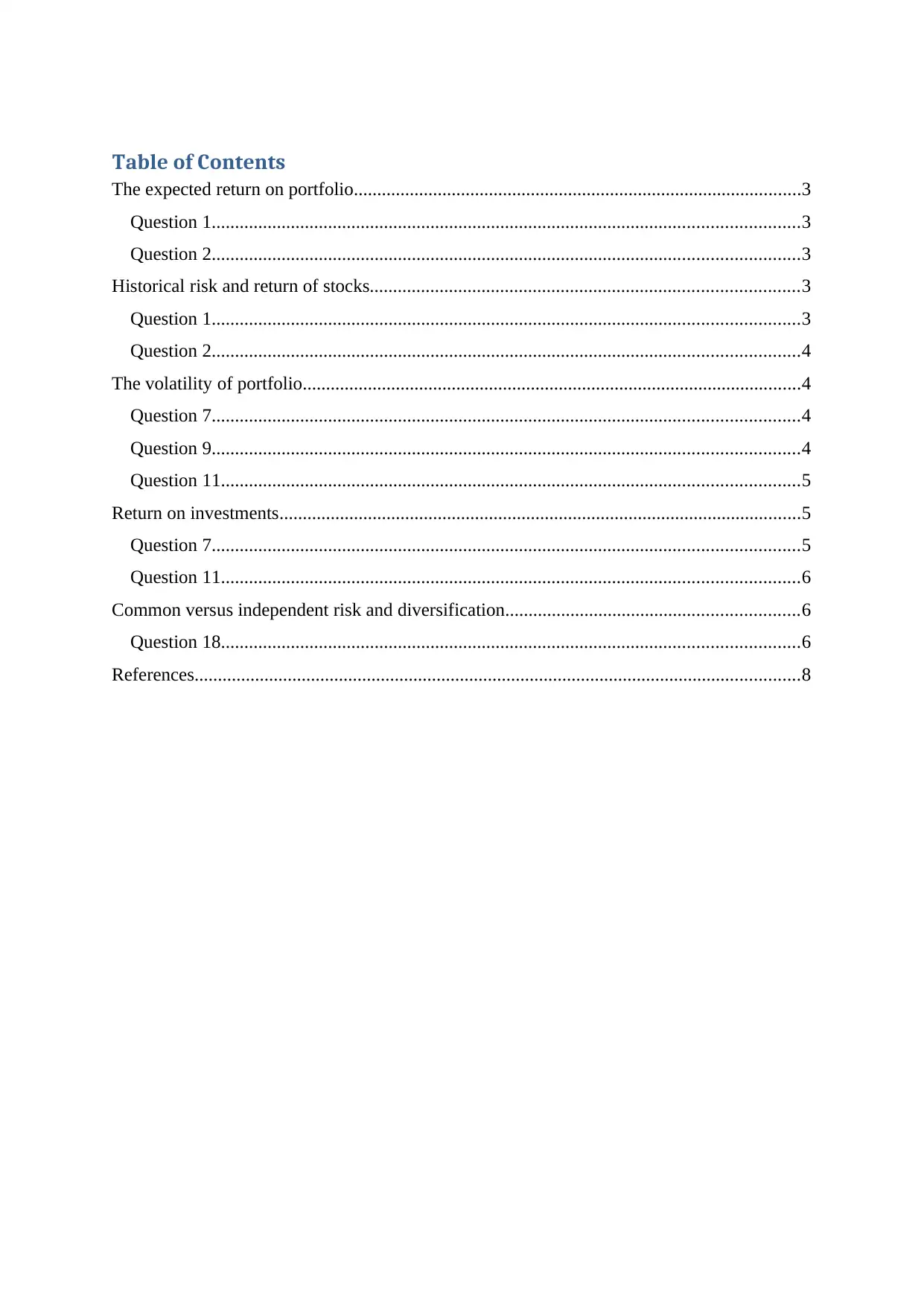
Table of Contents
The expected return on portfolio................................................................................................3
Question 1..............................................................................................................................3
Question 2..............................................................................................................................3
Historical risk and return of stocks............................................................................................3
Question 1..............................................................................................................................3
Question 2..............................................................................................................................4
The volatility of portfolio...........................................................................................................4
Question 7..............................................................................................................................4
Question 9..............................................................................................................................4
Question 11............................................................................................................................5
Return on investments................................................................................................................5
Question 7..............................................................................................................................5
Question 11............................................................................................................................6
Common versus independent risk and diversification...............................................................6
Question 18............................................................................................................................6
References..................................................................................................................................8
The expected return on portfolio................................................................................................3
Question 1..............................................................................................................................3
Question 2..............................................................................................................................3
Historical risk and return of stocks............................................................................................3
Question 1..............................................................................................................................3
Question 2..............................................................................................................................4
The volatility of portfolio...........................................................................................................4
Question 7..............................................................................................................................4
Question 9..............................................................................................................................4
Question 11............................................................................................................................5
Return on investments................................................................................................................5
Question 7..............................................................................................................................5
Question 11............................................................................................................................6
Common versus independent risk and diversification...............................................................6
Question 18............................................................................................................................6
References..................................................................................................................................8
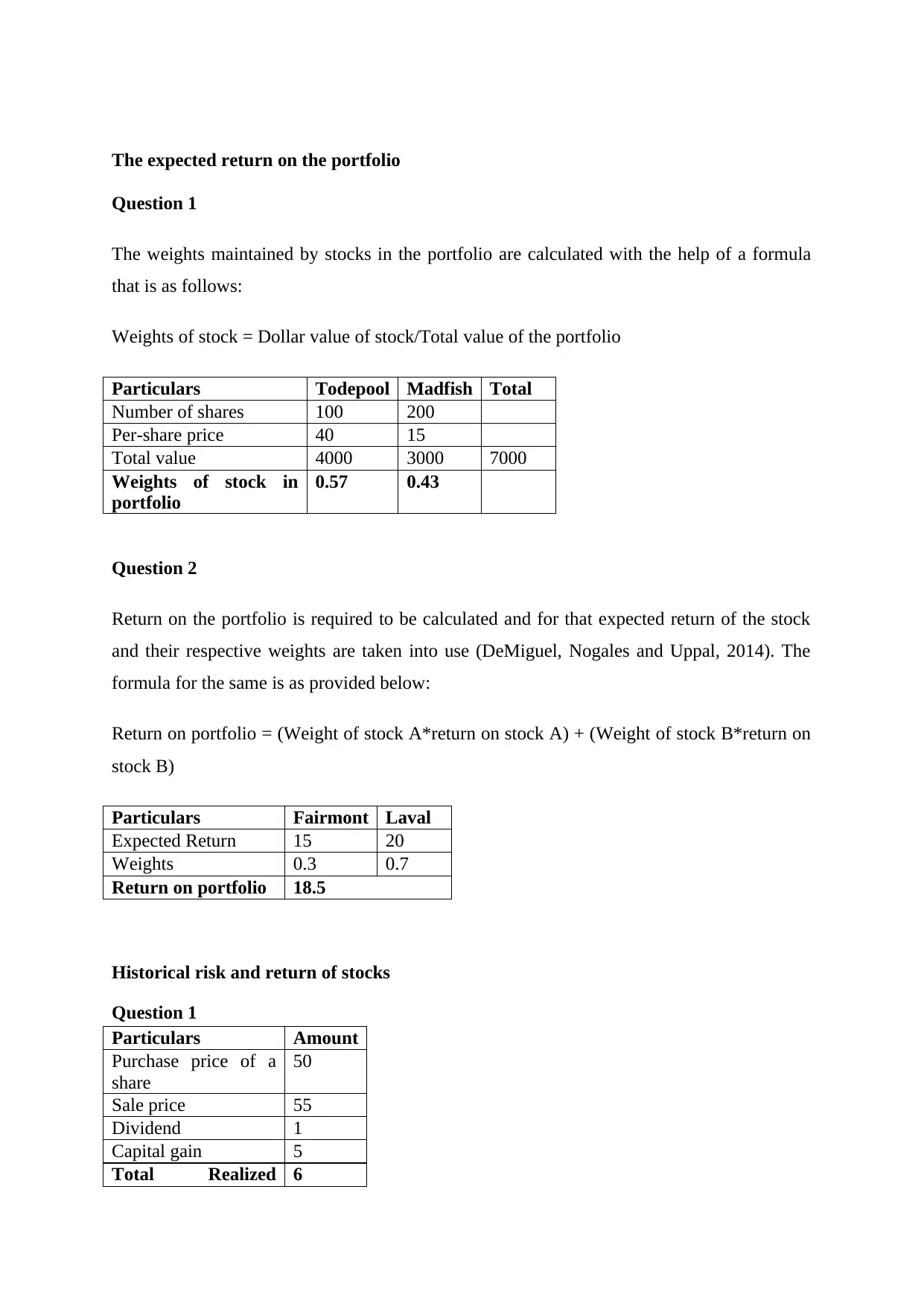
The expected return on the portfolio
Question 1
The weights maintained by stocks in the portfolio are calculated with the help of a formula
that is as follows:
Weights of stock = Dollar value of stock/Total value of the portfolio
Particulars Todepool Madfish Total
Number of shares 100 200
Per-share price 40 15
Total value 4000 3000 7000
Weights of stock in
portfolio
0.57 0.43
Question 2
Return on the portfolio is required to be calculated and for that expected return of the stock
and their respective weights are taken into use (DeMiguel, Nogales and Uppal, 2014). The
formula for the same is as provided below:
Return on portfolio = (Weight of stock A*return on stock A) + (Weight of stock B*return on
stock B)
Particulars Fairmont Laval
Expected Return 15 20
Weights 0.3 0.7
Return on portfolio 18.5
Historical risk and return of stocks
Question 1
Particulars Amount
Purchase price of a
share
50
Sale price 55
Dividend 1
Capital gain 5
Total Realized 6
Question 1
The weights maintained by stocks in the portfolio are calculated with the help of a formula
that is as follows:
Weights of stock = Dollar value of stock/Total value of the portfolio
Particulars Todepool Madfish Total
Number of shares 100 200
Per-share price 40 15
Total value 4000 3000 7000
Weights of stock in
portfolio
0.57 0.43
Question 2
Return on the portfolio is required to be calculated and for that expected return of the stock
and their respective weights are taken into use (DeMiguel, Nogales and Uppal, 2014). The
formula for the same is as provided below:
Return on portfolio = (Weight of stock A*return on stock A) + (Weight of stock B*return on
stock B)
Particulars Fairmont Laval
Expected Return 15 20
Weights 0.3 0.7
Return on portfolio 18.5
Historical risk and return of stocks
Question 1
Particulars Amount
Purchase price of a
share
50
Sale price 55
Dividend 1
Capital gain 5
Total Realized 6
⊘ This is a preview!⊘
Do you want full access?
Subscribe today to unlock all pages.

Trusted by 1+ million students worldwide
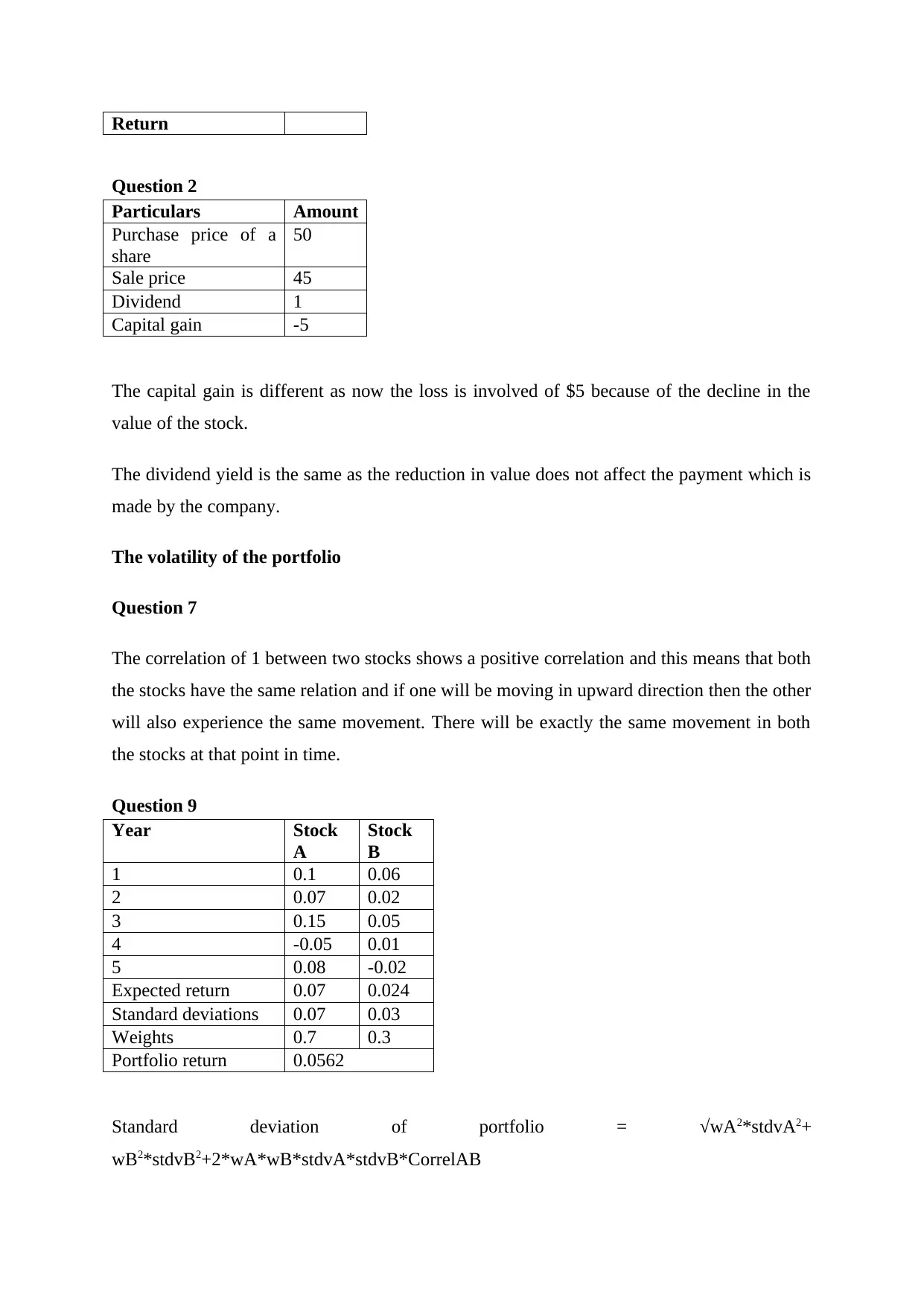
Return
Question 2
Particulars Amount
Purchase price of a
share
50
Sale price 45
Dividend 1
Capital gain -5
The capital gain is different as now the loss is involved of $5 because of the decline in the
value of the stock.
The dividend yield is the same as the reduction in value does not affect the payment which is
made by the company.
The volatility of the portfolio
Question 7
The correlation of 1 between two stocks shows a positive correlation and this means that both
the stocks have the same relation and if one will be moving in upward direction then the other
will also experience the same movement. There will be exactly the same movement in both
the stocks at that point in time.
Question 9
Year Stock
A
Stock
B
1 0.1 0.06
2 0.07 0.02
3 0.15 0.05
4 -0.05 0.01
5 0.08 -0.02
Expected return 0.07 0.024
Standard deviations 0.07 0.03
Weights 0.7 0.3
Portfolio return 0.0562
Standard deviation of portfolio = √wA2*stdvA2+
wB2*stdvB2+2*wA*wB*stdvA*stdvB*CorrelAB
Question 2
Particulars Amount
Purchase price of a
share
50
Sale price 45
Dividend 1
Capital gain -5
The capital gain is different as now the loss is involved of $5 because of the decline in the
value of the stock.
The dividend yield is the same as the reduction in value does not affect the payment which is
made by the company.
The volatility of the portfolio
Question 7
The correlation of 1 between two stocks shows a positive correlation and this means that both
the stocks have the same relation and if one will be moving in upward direction then the other
will also experience the same movement. There will be exactly the same movement in both
the stocks at that point in time.
Question 9
Year Stock
A
Stock
B
1 0.1 0.06
2 0.07 0.02
3 0.15 0.05
4 -0.05 0.01
5 0.08 -0.02
Expected return 0.07 0.024
Standard deviations 0.07 0.03
Weights 0.7 0.3
Portfolio return 0.0562
Standard deviation of portfolio = √wA2*stdvA2+
wB2*stdvB2+2*wA*wB*stdvA*stdvB*CorrelAB
Paraphrase This Document
Need a fresh take? Get an instant paraphrase of this document with our AI Paraphraser
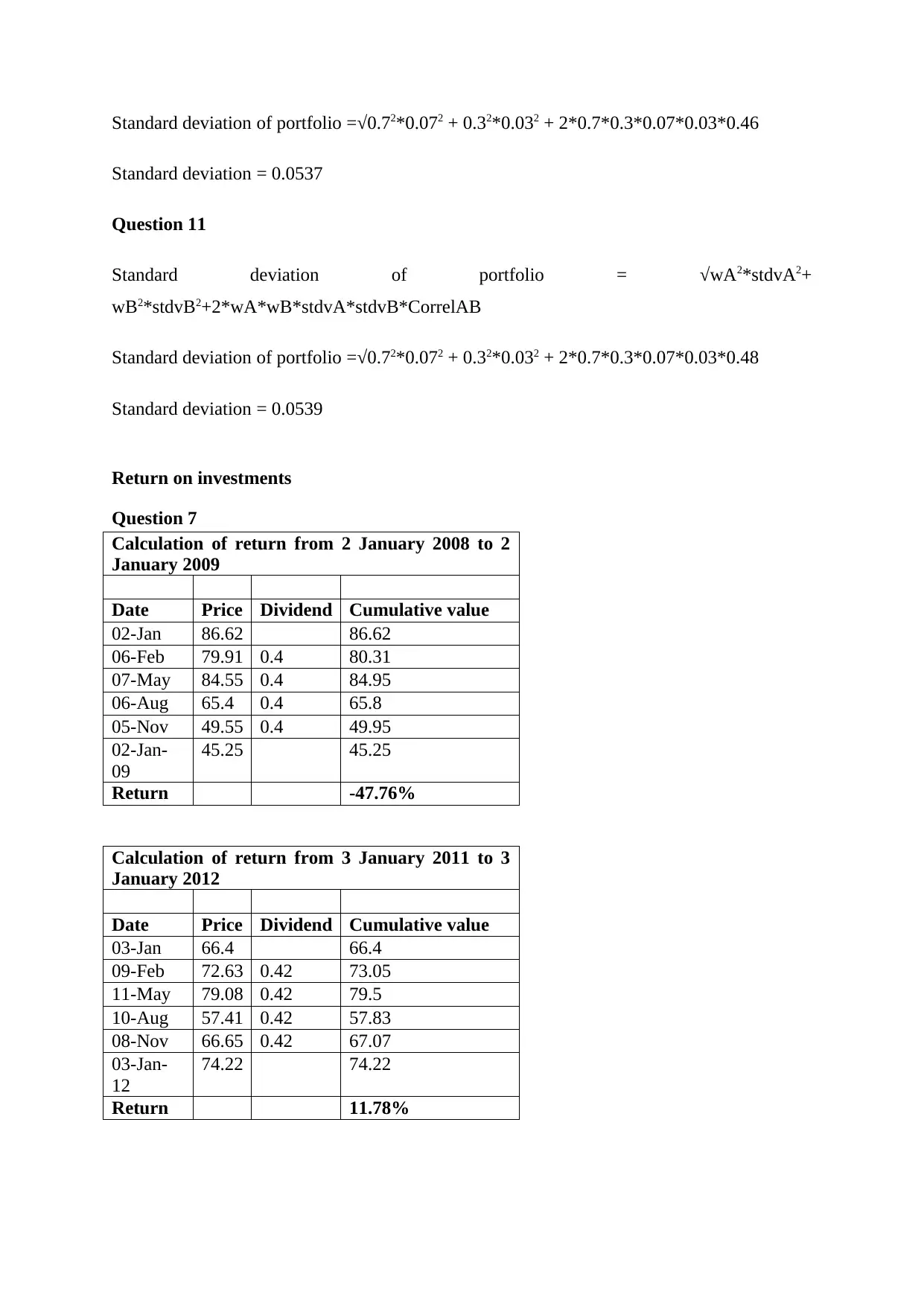
Standard deviation of portfolio =√0.72*0.072 + 0.32*0.032 + 2*0.7*0.3*0.07*0.03*0.46
Standard deviation = 0.0537
Question 11
Standard deviation of portfolio = √wA2*stdvA2+
wB2*stdvB2+2*wA*wB*stdvA*stdvB*CorrelAB
Standard deviation of portfolio =√0.72*0.072 + 0.32*0.032 + 2*0.7*0.3*0.07*0.03*0.48
Standard deviation = 0.0539
Return on investments
Question 7
Calculation of return from 2 January 2008 to 2
January 2009
Date Price Dividend Cumulative value
02-Jan 86.62 86.62
06-Feb 79.91 0.4 80.31
07-May 84.55 0.4 84.95
06-Aug 65.4 0.4 65.8
05-Nov 49.55 0.4 49.95
02-Jan-
09
45.25 45.25
Return -47.76%
Calculation of return from 3 January 2011 to 3
January 2012
Date Price Dividend Cumulative value
03-Jan 66.4 66.4
09-Feb 72.63 0.42 73.05
11-May 79.08 0.42 79.5
10-Aug 57.41 0.42 57.83
08-Nov 66.65 0.42 67.07
03-Jan-
12
74.22 74.22
Return 11.78%
Standard deviation = 0.0537
Question 11
Standard deviation of portfolio = √wA2*stdvA2+
wB2*stdvB2+2*wA*wB*stdvA*stdvB*CorrelAB
Standard deviation of portfolio =√0.72*0.072 + 0.32*0.032 + 2*0.7*0.3*0.07*0.03*0.48
Standard deviation = 0.0539
Return on investments
Question 7
Calculation of return from 2 January 2008 to 2
January 2009
Date Price Dividend Cumulative value
02-Jan 86.62 86.62
06-Feb 79.91 0.4 80.31
07-May 84.55 0.4 84.95
06-Aug 65.4 0.4 65.8
05-Nov 49.55 0.4 49.95
02-Jan-
09
45.25 45.25
Return -47.76%
Calculation of return from 3 January 2011 to 3
January 2012
Date Price Dividend Cumulative value
03-Jan 66.4 66.4
09-Feb 72.63 0.42 73.05
11-May 79.08 0.42 79.5
10-Aug 57.41 0.42 57.83
08-Nov 66.65 0.42 67.07
03-Jan-
12
74.22 74.22
Return 11.78%
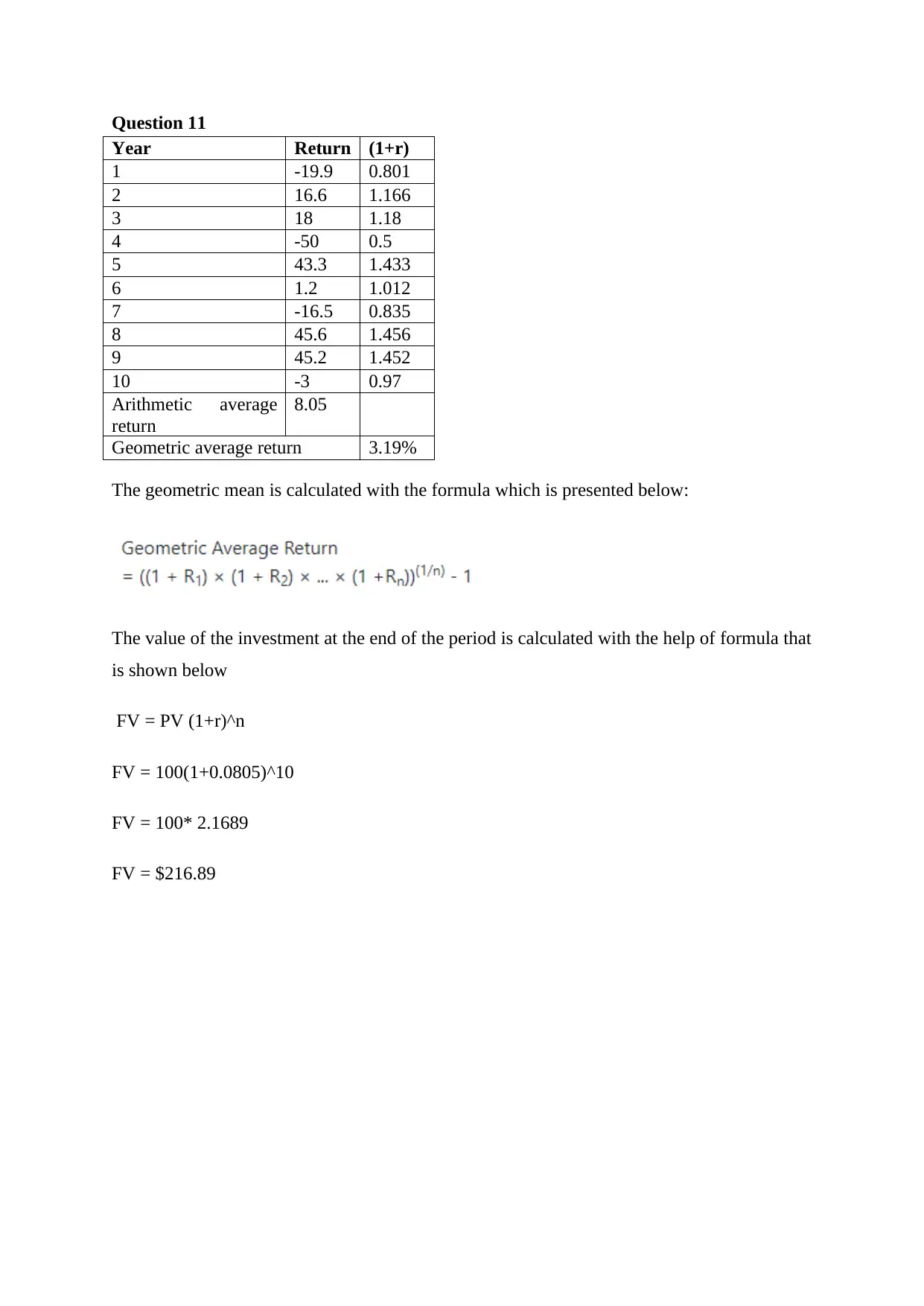
Question 11
Year Return (1+r)
1 -19.9 0.801
2 16.6 1.166
3 18 1.18
4 -50 0.5
5 43.3 1.433
6 1.2 1.012
7 -16.5 0.835
8 45.6 1.456
9 45.2 1.452
10 -3 0.97
Arithmetic average
return
8.05
Geometric average return 3.19%
The geometric mean is calculated with the formula which is presented below:
The value of the investment at the end of the period is calculated with the help of formula that
is shown below
FV = PV (1+r)^n
FV = 100(1+0.0805)^10
FV = 100* 2.1689
FV = $216.89
Year Return (1+r)
1 -19.9 0.801
2 16.6 1.166
3 18 1.18
4 -50 0.5
5 43.3 1.433
6 1.2 1.012
7 -16.5 0.835
8 45.6 1.456
9 45.2 1.452
10 -3 0.97
Arithmetic average
return
8.05
Geometric average return 3.19%
The geometric mean is calculated with the formula which is presented below:
The value of the investment at the end of the period is calculated with the help of formula that
is shown below
FV = PV (1+r)^n
FV = 100(1+0.0805)^10
FV = 100* 2.1689
FV = $216.89
⊘ This is a preview!⊘
Do you want full access?
Subscribe today to unlock all pages.

Trusted by 1+ million students worldwide
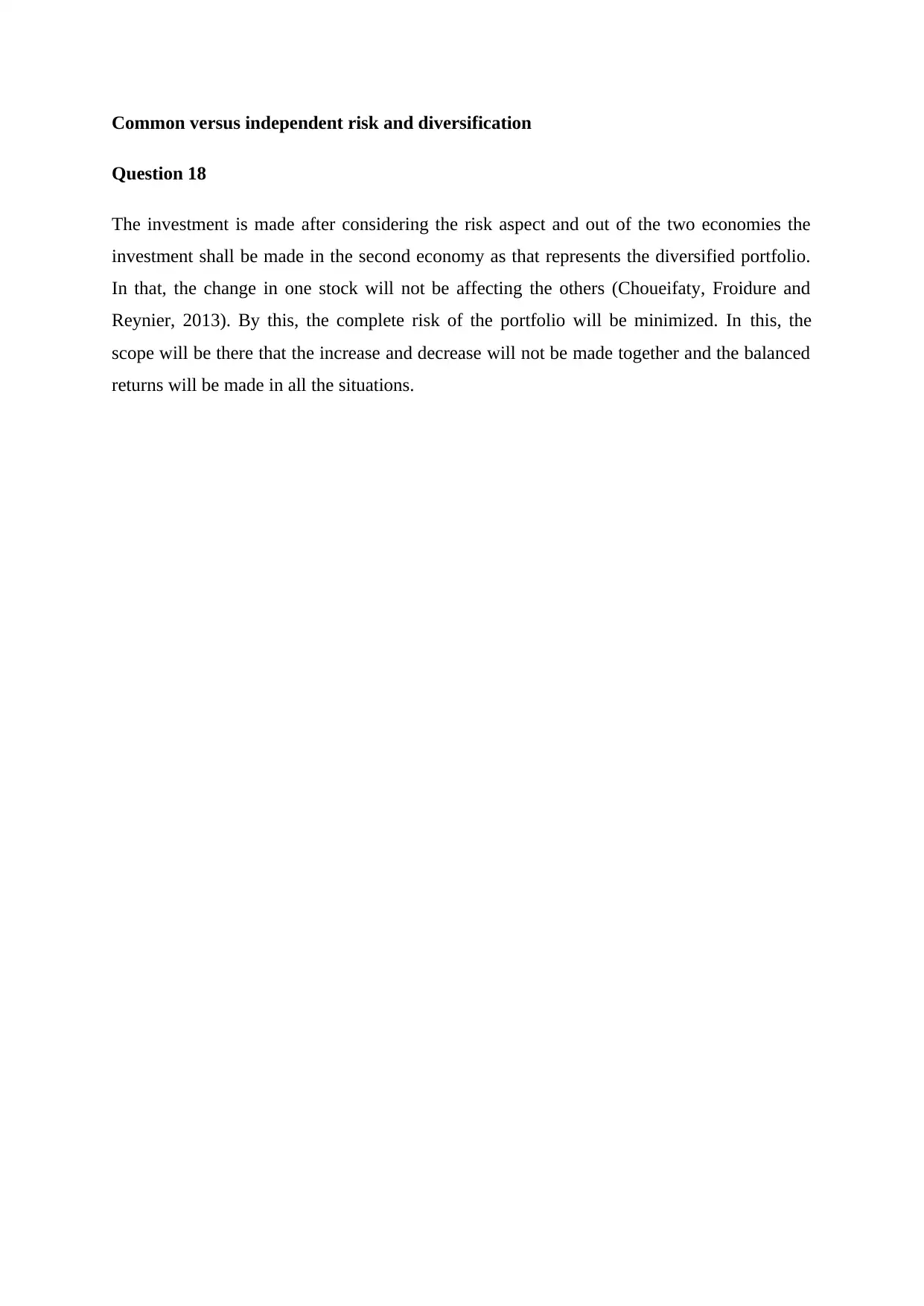
Common versus independent risk and diversification
Question 18
The investment is made after considering the risk aspect and out of the two economies the
investment shall be made in the second economy as that represents the diversified portfolio.
In that, the change in one stock will not be affecting the others (Choueifaty, Froidure and
Reynier, 2013). By this, the complete risk of the portfolio will be minimized. In this, the
scope will be there that the increase and decrease will not be made together and the balanced
returns will be made in all the situations.
Question 18
The investment is made after considering the risk aspect and out of the two economies the
investment shall be made in the second economy as that represents the diversified portfolio.
In that, the change in one stock will not be affecting the others (Choueifaty, Froidure and
Reynier, 2013). By this, the complete risk of the portfolio will be minimized. In this, the
scope will be there that the increase and decrease will not be made together and the balanced
returns will be made in all the situations.
Paraphrase This Document
Need a fresh take? Get an instant paraphrase of this document with our AI Paraphraser
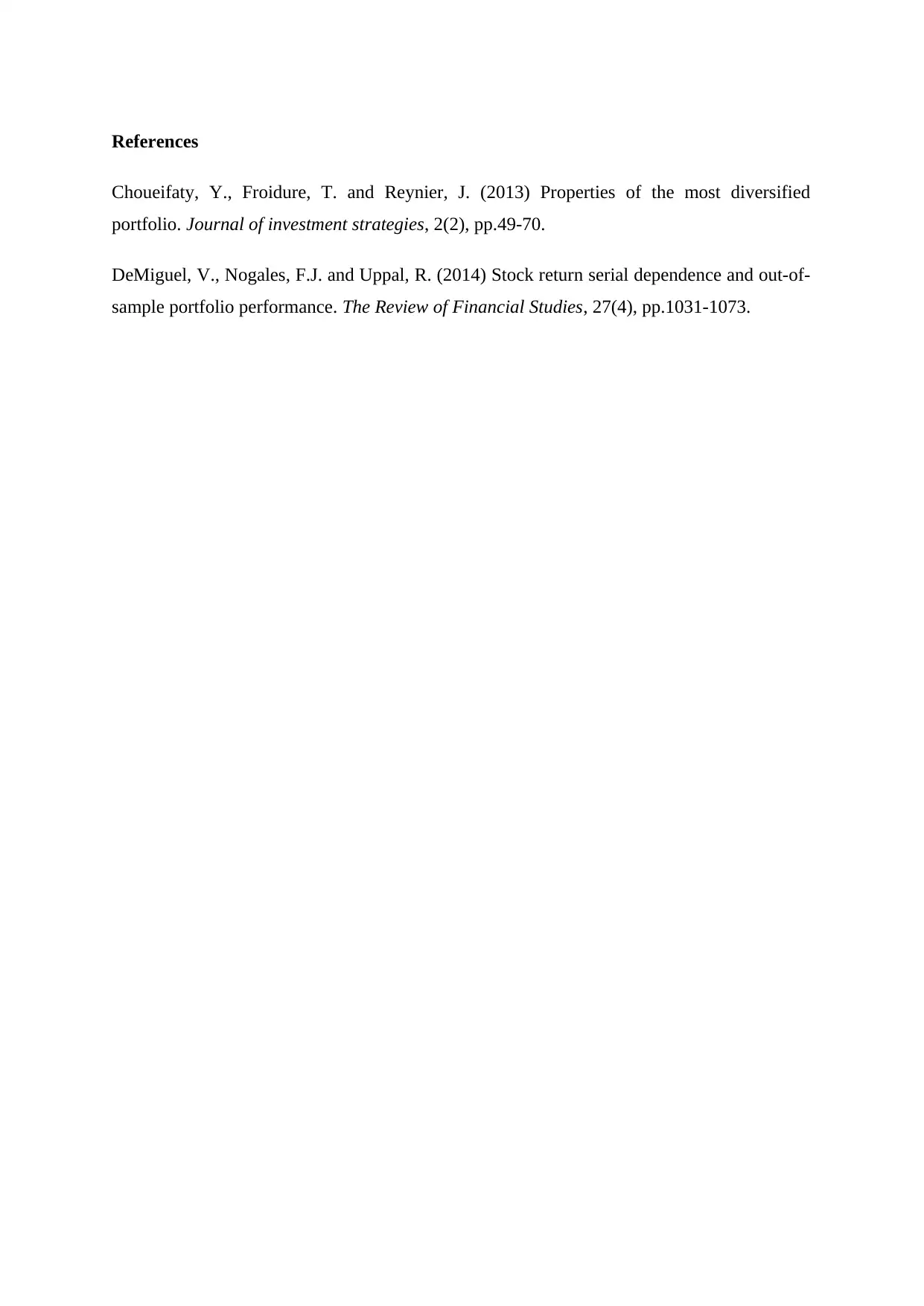
References
Choueifaty, Y., Froidure, T. and Reynier, J. (2013) Properties of the most diversified
portfolio. Journal of investment strategies, 2(2), pp.49-70.
DeMiguel, V., Nogales, F.J. and Uppal, R. (2014) Stock return serial dependence and out-of-
sample portfolio performance. The Review of Financial Studies, 27(4), pp.1031-1073.
Choueifaty, Y., Froidure, T. and Reynier, J. (2013) Properties of the most diversified
portfolio. Journal of investment strategies, 2(2), pp.49-70.
DeMiguel, V., Nogales, F.J. and Uppal, R. (2014) Stock return serial dependence and out-of-
sample portfolio performance. The Review of Financial Studies, 27(4), pp.1031-1073.
1 out of 8
Related Documents
Your All-in-One AI-Powered Toolkit for Academic Success.
+13062052269
info@desklib.com
Available 24*7 on WhatsApp / Email
![[object Object]](/_next/static/media/star-bottom.7253800d.svg)
Unlock your academic potential
Copyright © 2020–2025 A2Z Services. All Rights Reserved. Developed and managed by ZUCOL.




